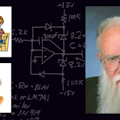Yes, I used to be a Boy Scout, and I think I earned about six Merit Badges. Did they have an Electricity or Electronics Merit Badge back in 1954? Probably, but I did not earn that one. I did pass swimming, though. So how can we get kids interested in electronics these days when there are no heathkits?
Well, I got some fun ideas. Let's look at the figure. We take an audio signal—such as one from a function generator, or a radio, or a record player, or a CD player. We patch it into the input of the amplifier network. Then we patch the output into an ordinary audio amplifier (Hi-Fi set) and listen to it. Depending on what components we insert into the amplifier stage, what does the output sound like?
If you put in weird capacitors, what does that sound like? If you add a diode or two, what does that sound like? If you make filters—low-pass, bandpass, or notch—does that sound pretty weird?
What if you scrape a grounded file across the terminals? Raspy, eh?? Filters? Oscillators? Refer to my Web site, www.national.com/rap, and search on "RAP's Merit Badge Workbook" for various recommended circuits. Do they sound weird? I hope so!
If you can borrow an oscilloscope, and you look at the waveforms, does the observed waveform make sense in terms of the audio weirdness? I have thought of several ways that I wanted to get kids involved with audio and with electronics as a hobby, and this is the best idea I have come up with so far.
Can they use a "solderless breadboard?" Oh, sure, this is one case where the impedances and frequencies are moderate, so the limitations of the "solderless breadboard" at high frequencies aren't harmful.
Do the Boy Scouts already have an Electronics Merit Badge? I am sure they do. I'll go search it out and try to understand it. But I think my ideas will be fun for the young experimenter. You can't get hurt—or electrocuted. You probably won't become deaf. I think even a Boy Scout who does not know a lot about electronics can learn and have fun with these experiments. And a kid who is not a Boy Scout can have fun, too!
BOB'S MAILBOXDear Bob: You ask "How many engineers who designed things in 1980 are still ALIVE?" (electronic design, March 15, p. 20). Millions! I am in touch with many of my contemporaries who are alive and kicking vigorously. (Okay, of course you are right. I was just overacting! However, a lot of guys who designed things in 1980 have changed companies, died, retired, etc. My point is that you can't have great confidence in finding such people. /rap) I have on hand an RF signal generator that I designed in 1944. (Yeah, but have you had to replace some of the electrolytics? Maybe so. /rap)I was still designing in 1980 and for several more years. Later, I tried to keep other engineers from making the all-too-common mistakes with which I was familiar, including failure to read the footnotes of a specification sheet. My last design was a couple of battery-operated emergency lights at home to turn on automatically in case of a power failure. Later I'll tell you about my 10,000-V ac test setup and my recent tests on insulation and the only human volunteer I could get—me.
Pease: Yeah, you might not get ME to volunteer. I hope you had a helper nearby to (A) turn off the power switch, (B) give some artificial respiration, and (C) call the emergency rescue team if needed!
Comments invited! [email protected] —or:
Mail Stop D2597A, National Semiconductor
P.O. Box 58090, Santa Clara, CA 95052-8090
About the Author

Bob Pease
Bob obtained a BSEE from MIT in 1961 and was a staff scientist at National Semiconductor Corp., Santa Clara, CA, for many years. He was a well known and long time contributing editor to Electronic Design.
We also have a number of PDF eBooks by Bob that members can download from the Electronic Design Members Library.